
The United States Pacific Fleet (USPACFLT) is a theater-level component command of the United States Navy, located in the Pacific Ocean. It provides naval forces to the Indo-Pacific Command. Fleet headquarters is at Joint Base Pearl Harbor–Hickam, Hawaii, with large secondary facilities at Naval Air Station North Island, California.
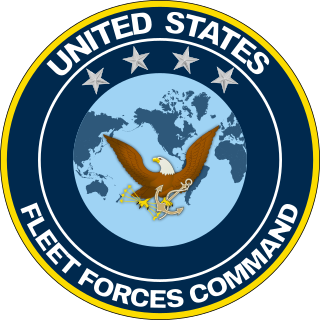
The United States Fleet Forces Command (USFF) is a service component command of the United States Navy that provides naval forces to a wide variety of U.S. forces. The naval resources may be allocated to Combatant Commanders such as United States Northern Command (USNORTHCOM) under the authority of the Secretary of Defense. Originally formed as United States Atlantic Fleet (USLANTFLT) in 1906, it has been an integral part of the defense of the United States of America since the early 20th century. In 2002, the Fleet comprised over 118,000 Navy and Marine Corps personnel serving on 186 ships and in 1,300 aircraft, with an area of responsibility ranging over most of the Atlantic Ocean from the North Pole to the South Pole, the Caribbean Sea, Gulf of Mexico, and the waters of the Pacific Ocean along the coasts of Central and South America.

The Sixth Fleet is a numbered fleet of the United States Navy operating as part of United States Naval Forces Europe-Africa. The Sixth Fleet is headquartered at Naval Support Activity Naples, Italy. The officially stated mission of the Sixth Fleet in 2011 is that it "conducts the full range of Maritime Operations and Theater Security Cooperation missions, in concert with coalition, joint, interagency, and other parties, in order to advance security and stability in Europe and Africa." The current commander of the Sixth Fleet is Vice Admiral Thomas E. Ishee.
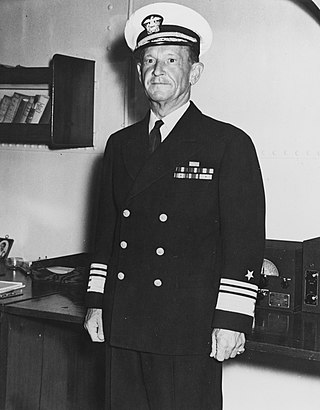
Frank Jack Fletcher was an admiral in the United States Navy during World War II. Fletcher commanded five different task forces through the war; he was the operational task force commander at the pivotal battles of the Coral Sea and Midway, which collectively resulted in the sinking of five Japanese fleet carriers.

The First Fleet was a numbered fleet of the United States Navy, in operation from January 1947 to 1 February 1973 in the western Pacific Ocean as part of the Pacific Fleet. In 1973, it was disestablished and its duties assumed by the United States Third Fleet.

Robert Bostwick Carney was an admiral in the United States Navy who served as commander-in-chief of the NATO forces in Southern Europe (1951–1953) and then as Chief of Naval Operations (1953–1954) during the Eisenhower administration.
The Scouting Fleet was created in 1922 as part of a major, post-World War I reorganization of the United States Navy. The Atlantic and Pacific fleets, which comprised a significant portion of the ships in the United States Navy, were combined into a new entity, the United States Fleet. Defined as "the principal naval force of the United States," the new fleet was composed of four elements: (a) the Battle Fleet, (b) the Scouting Fleet, (c) the Control Force, and (d) the Fleet Base Force. Under the general heading of "Forces Not Assigned to the United States Fleet" came six categories: (a) Asiatic Fleet; (b) Naval Forces, Europe; (c) Special Service Squadrons; (d) Submarine Divisions, Atlantic; (e) Submarine Divisions, Pacific; and (f) Naval District Forces. While there was a reorganization in 1930, and the renaming of the Battle Fleet and Scouting Fleet as the Battle Force and Scouting Force, this would be the core structure of the United States Navy until the beginning of World War II.
The United States Battle Fleet or Battle Force was part of the organization of the United States Navy from 1922 to 1941.
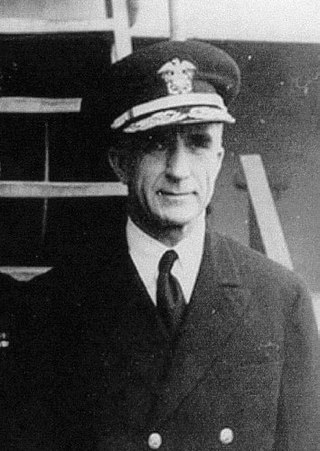
Vice Admiral Morton Lyndholm Deyo was an officer in the United States Navy, who was a naval gunfire support task force commander of World War II.

Rear Admiral Gilbert Jonathan Rowcliff was an officer of the United States Navy during the First World War and the Second World War. After early service in the Far East, he specialised in gunnery, serving in that capacity on many US Navy capital ships. During World War I he served with the US Naval Force sent to join the British Grand Fleet.

Walter Stratton Anderson was a Vice Admiral of the United States Navy, who served as the Executive officer of USS Arizona in World War I and as Commander Battleships, Battle Force in the Pacific Fleet, and of the Gulf Sea Frontier, during World War II.
Service Force, United States Pacific Fleet, usually known as COMSERVPAC, was a service support command of the United States Pacific Fleet from 1942 until 1973. It was the reincarnation of the former Base Force. The Service Force comprised the supply train of the fleet which includes Oilers (AO), Gasoline Tanker (AOG), Repair Ships (AR), Ammunition Ships (AE), Destroyer Tenders (AD) and Submarine tenders (AS).

Admiral Louis Rodolph de Steiguer was an officer in the U.S. Navy. He was Commander of the U.S. Battle Fleet from 1927 to 1928.

Louis McCoy Nulton was a four-star admiral in the United States Navy who was superintendent of the U.S. Naval Academy from 1925 to 1928 and commander of the Battle Fleet from 1929 to 1930.
Vice Admiral Ferdinand Louis Reichmuth was an officer of the United States Navy who served in World War I and World War II.
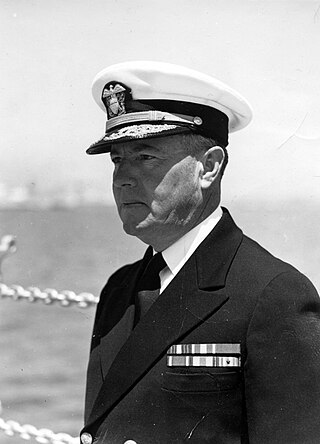
John Wills Greenslade was a highly decorated officer in the United States Navy with the rank of Vice Admiral. He enjoyed a significant military career, participating in several conflicts and distinguished himself during World War I as Commanding officer, USS Housatonic and during World War II as Commander, Western Sea Frontier and Commandant, Twelfth Naval district with headquarters at Mare Island Naval Shipyard.

Donald Bradford Beary was a vice admiral of the United States Navy. His career included service in both World War I and World War II and a tour as President of the Naval War College. He commanded a wide variety of ships and organizations, and is particularly noted for his leadership during World War II in establishing and directing a large-scale U.S. Navy training program and for his pioneering and highly successful work as a commander of U.S. Navy underway replenishment forces.

The Commander, Naval Surface Force Pacific (COMNAVSURFPAC) is a senior command position in the United States Navy who leads the Naval Surface Force of the United States Pacific Fleet. The COMNAVSURFPAC also leads the Naval Surface Force (COMNAVSURFOR) and the Surface Warfare Enterprise. The position is typically held by a Vice-Admiral. From 1978 onwards, the headquarters has been located at Naval Amphibious Base Coronado, Coronado, California.

Herbert Douglas Riley was a highly decorated officer in the United States Navy with the rank of Vice admiral. A United States Naval Academy graduate, he trained as naval aviator and distinguished himself first as commanding officer of the escort carrier USS Makassar Strait during the combats at Iwo Jima and Okinawa during World War II.
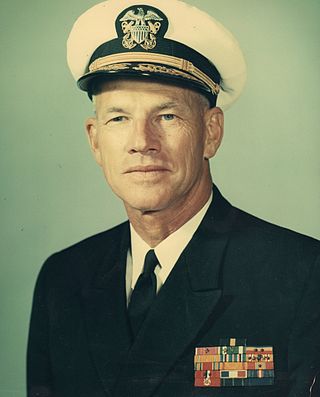
Lloyd Montague Mustin was a vice admiral in the United States Navy and among the namesakes of USS Mustin (DDG-89). He took part in developing the Navy's first lead-computing anti-aircraft gun sight, which proved of major importance in the air-sea actions of World War II, and he served on the cruiser USS Atlanta during the naval battle of Guadalcanal. His ship was lost during that action, and with other survivors he landed on Guadalcanal and served ashore with a naval unit attached to the First Marine Division. His postwar service included commands at sea and development and evaluation of weapon systems. He later served as director of operations for the Joint Chiefs of Staff during the Vietnam War.















